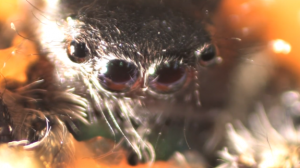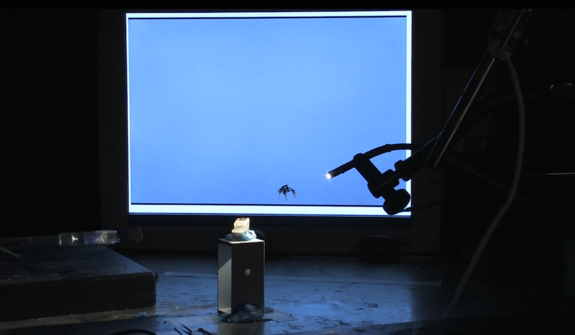3D printing just became the natural ally of every arachnophobe who shivered at the prospect of jumping spiders — as though the ones that scurry out from beneath beds and spontaneously dangle two inches from one’s face were not enough to elicit shudders. Thanks to some neurobiology researchers at Cornell University’s Hoy Lab, there is now a 3D printed jumping spider harness, designed expressly to keep the acrobatic arachnids in place while they are being studied. 
The research team, consisting of Gil Menda, Paul S. Shamble, Eyal I. Nitzany, James R. Golden, and Ronald R. Hoy, are interested in why the jumping spider (the Latin name for the species is Phidippus audax, of the family Salticidae) seems to be an anomaly where spider vision is concerned. While most spiders have poor vision and must construct webs in order to catch their prey, jumping spiders have superb vision — nearly as good as that of humans — and are gifted hunters that stalk their prey, which consists for the most part of flies and moths.
The Cornell researchers wanted to understand the structure and functioning of this particular spider’s visual system (specifically, the brain’s neurons) but studying the brain of the jumping spider proved more challenging than they’d anticipated. Each time they attempted to examine the spiders’ brains, the study subjects would literally explode. This is because the bodies of these spiders are filled with a liquid that is highly pressurized, enabling their bodies to move, something like tiny hydraulic systems. When the jumping spiders’ bodies were pierced, the creatures would burst, the spiders would die, end of experiment.
To hold the jumping spiders in place while they studied them, the lab team devised a tiny, 3D printed plastic harness shaped somewhat like an upper-case letter “I.” In essence, the harness is clamped down over the body of the spider and warm wax is placed over both to keep the study subject in place. As the experiment involves inserting a tiny, hair’s-width electrode into the brain of the arachnid, any movement would skew the results. Menda devised a method for creating a self-sealing hole in the spider’s head so the electrode could be inserted.
Once the spider is restrained in its waxy harness, the researchers show it images of flies as well as other jumping spiders (“A Clockwork Orange” comes to mind). When the spiders saw pictures of flies, there was a notable jump in their brains’ electrical activity. Evidently, the eight eyes of spiders have differing functions. While the primary pair, the larger of the jumping spider’s eyes sees objects and details, the secondary four eyes process motion.

The spider in its harness was placed in the middle of the room while researchers showed it images of flies and other jumping spiders to record its brain waves
The Cornell University researchers have published the results of their study along with some pretty remarkable photographs, including fantastic close-ups of the 3D printed, clear plastic harness. Check out a video from the researchers detailing the whole process on Cornell’s site, too! Let us know your thoughts on this incredibly interesting use of 3D printing, in the 3D Printed Spider Harness forum thread on 3DPB.com.
Subscribe to Our Email Newsletter
Stay up-to-date on all the latest news from the 3D printing industry and receive information and offers from third party vendors.
You May Also Like
3D Printed Heat Spreader Could Improve Efficiency of Electronics
The low-hanging fruit for decarbonization has long been improving the efficiency of existing systems, hence the justification for LED lights and ENERGY STAR certified appliances. While such minor moves are...
3D Printing News Unpeeled: Marine Gearboxes, 3D Printed Motors and $1.7 Million in Seed Funding
UK based Equipmake just released their Ampere-220 e-axle system. The system, which is meant for high performance electric cars, was similar to one released on the Ariel HIPERCAR. It has...
CEAD Unveils 36-Meter-Long 3D Printer for Abu Dhabi’s Al Seer Marine
CEAD, a Dutch original equipment manufacturer dedicated to large-format 3D printers, has unveiled what it claims to be the world’s largest robotic arm-based 3D printer. At 36 meters long and...
3D Printed Biocomposites Could Help Reduce Marine Plastic Pollution
Concerns about the impact of plastic litter and microplastics in the oceans are at the forefront of environmental study. For decades, the marine environment has suffered from the degradation of...





































